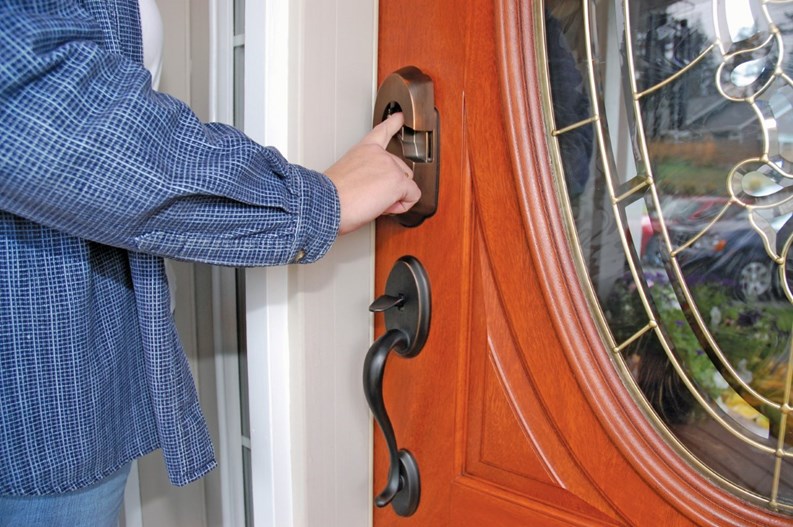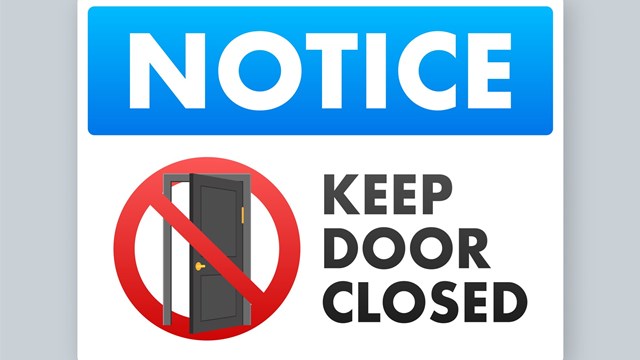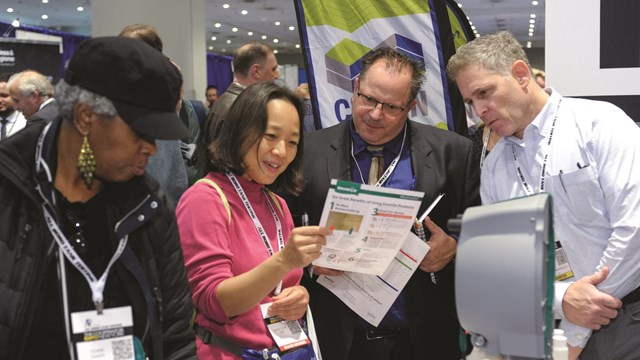Americans have always loved high-tech gadgets. Whether it’s an elaborate crime being solved on CSI or James Bond using a laser-guided device to defeat the bad guys, razor's-edge technology is endlessly entertaining.
But when it comes to real life—such as dealing with security issues in a condo building or association—high-tech devices are embraced only up to a point. Security-conscious condos like advanced technology, but it must pass muster on a number of levels.
In today’s economy, security is still a priority but according to those working in the industry, demand for high-tech devices is trending down. No association wants to lay out scarce cash on exotic security devices that only Hollywood producers could afford. Likewise, no owner wants to grapple with security that requires memorizing a 524-page manual and multiple passwords.
While boards and residents may still be willing to buy and install high-tech security, their expectations have changed lately. They’re now looking for designs based on proven technologies versus more trendy experimental ones. Unwilling to simply write a blank check, HOAs are looking to create value with up-to-date features combined in innovative ways with the tried-and-true. Retinal scanners and voice recognition are extremely cool, but fingerprint recognition systems do pretty much the same job for a much cheaper price.
That being said, let's take a look at some of the current leading-edge technology available to condo buildings and HOAs looking to improve their security profile.
Bio-Metrics
According to James Childers, CEO of Biometrics Direct in Freeland, Washington, fingerprint access is usually deployed in three main areas of a building or association: at entrances to the condo itself, at entry points to common areas, at the front doors of individual units.
Access control to the condo’s perimeter entrances is through a combination of a smart card or PIN and fingerprint authentication. Owners who have permission to enter the building are registered in the system by having their thumb electronically scanned. That scan does not remain a raw fingerprint, but is converted into a string of numbers that represent the print. Once a registered owner presses his or her thumb for entry, an advanced algorithm performs an authentication process, done in milliseconds, and accurate to .00001 percent, according to Childers.
Childers says that installing fingerprint access to a condo’s exterior entrances costs about $1,000 a door, and needs to be done by a licensed electrician. The door also needs to be tied into the fire alarm system, to make it compliant with local codes. Authentication at the unit owner’s door is done only using a fingerprint—skipping the smart card or PIN. The entire system is contained in a device that costs under $300 and can be retrofitted into existing doors, essentially replacing the deadbolt.
Apartment owners can also set up fingerprint access “zones” within their units—like their bedroom, for example—which “limits access to certain parties,” says Childers, adding that limited access zones can also be very useful for art collectors or gun owners who want a dedicated room for security reasons. Finally, owners can set up a fingerprint-accessed “panic” or “safe room” to retreat to in case of an armed intruder or other danger.
Unit owners who have fingerprint recognition are finding that it increases both security and convenience, says Childers. Homeowners who have someone watch their home while they’re away can “enroll” the house sitter by having them enter their fingerprint and then setting an expiration date after which the fingerprint no longer works. “If you have someone house-sit, you’re going to have to give them a key," says Childers. "They could make a copy—or multiple copies."
Childers says he uses the fingerprint enrollment to simplify access for family members who regularly visit him. “Your kids, your parents, your family members, you don’t have to give them a key. When everybody comes over to my house for Thanksgiving or Christmas, I don’t have to wait up until two in the morning until Uncle Joey shows up. His fingerprints are already in my lock, and when he shows up he already knows where the guest bedroom is. It really does simplify it.”
Other owners enjoy not having to bother with house keys, says Childers. “If you’re going for a run in the morning, or go out for a bagel, why even carry a key? It simplifies your life.”
Similarly, when maintenance or repair staff needs to enter a unit, they can be let in by the on-site property manager or maintenance supervisor, whose fingerprint can be enrolled beforehand. The property manager will still need to keep keys for backup or override in the common areas, but the number of keys in circulation will be greatly reduced and access more tightly controlled. In addition, Childers says, fingerprint access locks keep a record of who entered the condo and the exact time they stayed, which can be quite helpful in crime control.
License Plate Recognition
License plate recognition (LPR) is a pairing of high-tech video cameras with law enforcement crime databases that have the potential to immediately notify police if a wanted criminal enters the condo grounds. This new tool was originally used by law enforcement, but community associations are also starting to deploy it on their own properties.
Anchoring the system is a high-powered camera that discreetly monitors the condo entrance. When a car enters, the system produces a color still image of the vehicle, and “reads” its license plate. That visual is fed into a sophisticated onboard processor that converts it into recognizable numbers and letters. The numbers and letters can then be compared to a police database, looking for “hits”—stolen cars, sex offenders or wanted criminals.
The system, which costs between $10,000 and $100,000 depending on the number of vehicle entrances, has a number of advantages over storing continuous video on Digital Video Recorders (DVRs), says Trace Trylko, media and public relations coordinator for NDI Technologies, Inc. in Longwood, Florida. “If an incident occurs, police or on-site security can scan endless hours of DVR video, and still may not be able to make out the license plate number due to rain, fog or darkness,” he says. “Here, the high-tech camera, day or night, is going to capture the license plate number,” he says, noting that storage requirements for LPR data are minimal.
The kind of record produced by LPR is uniquely useful to law enforcement and on-site security personnel, says Trylko.
Citing a real-life example, Trylko relates, “A car was broken into and the credit cards were used at 4:30 in the morning. Well, law enforcement wanted to see who’s been in the community between midnight and four. They looked at the plates and one of them matches our suspect.
“We know the particular make, model and license plate. He was in the community at 3:30 and he was the only car that entered. And we have this car as a suspect in another case. And the driver of that car was on the surveillance video at the convenience store where he tried to use the stolen credit cards. Then they (police) can piece it together,” says Trylko. “For the crime analyst, it’s a tremendous tool.”
Because the system’s implementation is so new in condominiums, future agreements between police and community associations and how the data will be used—in real time or not—will likely have to be worked out individually. “There would have to be an arrangement between the community and the law enforcement agency. It would vary community to community and law enforcement agency to law enforcement agency,” says Trylko.
Although LPR’s implementation in U.S. HOAs is in its early stages, Trylko says the system has been perfected over decades of use in Europe, where it performs multiple duties, ranging from assessing tolls and parking tickets to tracking terror suspects.
Privacy advocates in Europe and the U.S. have raised concerns over LPR’s misuse as an information-gathering tool for Big Brother. Those concerns have been somewhat mitigated by safeguards to keep tight control over the data, which includes the comings and goings of average citizens. “It’s not like the HOA president is going to be able to poke through license plate numbers,” says Trylko. Auto theft victims whose cars were quickly recovered due to LPR have expressed almost unanimous support for the technology.
Looking to the future, Trylko foresees many other condos deploying LPR. “I think this association in South Florida is just the first of what will be many. You don’t want to act defensively to a problem," he says, "you want to act proactively.”
Video Analytics
Video analytics takes the old model of a bored security guard before an array of video monitors and replaces the guard with a super-smart computer. Dubbed video analytics or “advanced video monitoring,” the brainy computer is able to scan a community association’s video feed 24/7 and notify human security personnel when it spots suspicious activities, according to Brian McCabe, chief information officer with Wackenhut Corporation Security Services, a national firm with offices throughout the tri-state area.
“If you have a camera and software you can determine certain types of events,” says McBride. “If there’s a bunch of kids loitering, we can pick that up. If there’s a crowd of people within a certain distance [of a building,] it will set off an alarm.”
While the system is not foolproof, it doesn’t waste a human’s time with false alarms like those often generated by motion detectors, says McCabe. “Video analytics has the intelligence to distinguish between a person or an animal, leaves blowing in the yard, or a vehicle driving,” he says.
If the computer should determine that criminal activity may be taking place, an alarm sounds and a guard at a remote monitoring and data center will be presented with a seven-second, high resolution video to determine what is going on. If the guard decides they need more information to sort out the event, he or she can scroll back and forth through the continuously-recording video to determine exactly what’s happening.
If the guard monitoring the video feed decides an event warrants investigation or intervention, they will immediately notify the on-site guard, who can respond and possibly summon local law enforcement.
In addition to video analytics, next-generation video technology enables so-called “virtual guard tours.” These tours—typically done once an hour—involve a remote live guard viewing a sequence of different cameras to simulate walking through the condo property, covering the parking lot, lobbies, elevators, pools, and so forth. By combining virtual guard tours with conventional guards, condos can both improve coverage and save money, says McBride.
“Let’s say we have a [live] guard there who does four rounds a night, and then we augment him with a virtual guard tour. So we do both—we do more frequent tours, and we do this with fewer people. So we can do more with less with the technology,” he says.
The hardware requirements of the system are also set up to do more with less. New cameras with built-in DVRs and analytics software range from $1,500 to $1,700, but existing analog cameras can often be retrofitted to work with the new system, says McBride. “We can plug in a third-party device that integrates the [analog] camera with video analytics.”
Elaborating on the system requirements, McBride says most properties can get excellent coverage with a mix of new and old cameras. “It doesn’t require customers to rip out everything they bought and replace them with all new stuff. That’s not practical. So we want to protect their past investments and augment that with newer technology.”
That combination of old and new technology, cutting-edge with legacy equipment is a formula that many security-conscious condominiums can embrace these days.
Jim Douglass is the managing editor of New England Condominium magazine, a Yale Robbins’ publication.







Leave a Comment